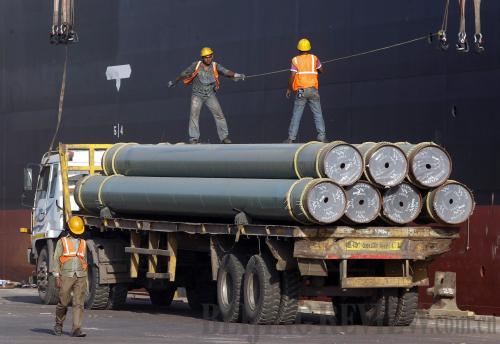|
In 2005, South Korean steel magnate Pohang Iron and Steel Co. Ltd. (POSCO) signed a contract with the Indian Government to build a factory in Orissa with an annual output of 12 million tons of steel. The project was supposed to include $1.2 billion of South Korean investments and was then the largest foreign direct investment in India. If completed, the steel plant would have become the third largest in the world. However, eight years after signing the contract, obstacles continued to prevent land acquisition for the project. POSCO finally abandoned its investment plan in 2013.
Mei said similar cases like the POSCO project are common in India. "Such political risks in India are greater than those in most other countries. We should never underestimate the challenges of industrial investment in India."
Apart from the political factors, the country's poor infrastructure is another major bottleneck in its ability to attract foreign investment to its manufacturing sector.
The vast electricity blackout in 2012 highlighted India's shoddy infrastructure. But on top of the outdated power grids, a poor transportation system and communication infrastructure also mars the country's image. According to the Global Competitiveness Report 2013-14 issued by the World Economic Forum, despite being an economic heavyweight, the global competitiveness of India's infrastructure ranks the 85th, even below Sri Lanka and Ecuador.
In addition, inadequate basic education harms what would otherwise be an advantageous demographic makeup. A report by U.N. Educational, Scientific and Cultural Organization released in the beginning of 2014 says India currently has 287 million illiterate adults, the largest population globally and 37 percent of the world total. Even after completing four years of school, 90 percent of Indian children from poorer households remain illiterate. This also holds true for around 30 percent of children from poorer homes despite receiving five to six years of schooling.
Learning and progressing
 |
|
GUJARATI POWER: Workers affix the hook of a crane to load pipes onto a ship at Mundra Port in the west Indian state of Gujarat on April 1 (CFP) |
To turn its vast population and other economic hurdles into comparative advantages, India could learn from and cooperate with China—a proven manufacturing power and important neighbor—on its road to becoming a global manufacturing powerhouse.
Lan Jianxue, an associate researcher with the China Institute of International Studies, said that while India traditionally stressed its service industry, China took the path of developing its manufacturing sector and, as such, each country developed its own set of strengths. In addition, China started its reform and opening-up policy a little earlier than India, allowing it to develop relatively faster and accumulate more experience in manufacturing.
China's manufacturing advantages—including technology and capital—could be of use in India's own path to development, said Lan.
Wang of CICIR told Beijing Review that China views India as a vast potential market and an ideal investment destination. At the same time, as China undergoes a wave of industrial upgrading, manufacturing businesses are actively looking for investment opportunities in other countries.
"India lacks both the funds and the experience to construct extensive infrastructure; thus, teaming up with China is key to realizing India's ambitions," Lan said to Beijing Review.
For the past several years, China-India relations have improved quickly. Last year, the government heads of the two countries exchanged visits within a 12-month period for the first time ever, with Chinese Premier Li Keqiang's visit to New Delhi being his first foreign trip since taking office. Not long ago, during the 2014 BRICS summit, Chinese President Xi Jinping invited India's new Prime Minister Modi to take part in the 2014 APEC Summit, which will be held in Beijing this autumn. It is the first time that an Indian leader was invited to attend the APEC Summit; meanwhile, it was reported that President Xi will travel to New Delhi in mid-September.
| 